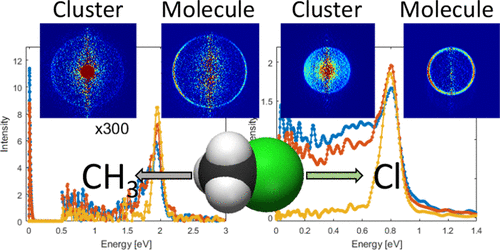当前位置:
X-MOL 学术
›
J. Phys. Chem. A
›
论文详情
Our official English website, www.x-mol.net, welcomes your
feedback! (Note: you will need to create a separate account there.)
Different Dynamics of CH3 and Cl Fragments from Photodissociation of CH3Cl in Clusters.
The Journal of Physical Chemistry A ( IF 2.7 ) Pub Date : 2020-08-31 , DOI: 10.1021/acs.jpca.0c05926 Ivo S Vinklárek 1, 2 , Jozef Rakovský 1 , Viktoriya Poterya 1 , Michal Fárník 1
The Journal of Physical Chemistry A ( IF 2.7 ) Pub Date : 2020-08-31 , DOI: 10.1021/acs.jpca.0c05926 Ivo S Vinklárek 1, 2 , Jozef Rakovský 1 , Viktoriya Poterya 1 , Michal Fárník 1
Affiliation

|
We investigate the photodissociation of CH3Cl at 193.3 nm using the velocity map imaging technique in (CH3Cl)n clusters in comparison with isolated molecules. Our results for the isolated molecules are in excellent agreement with the previous study of Cl fragments, and we extend it by detecting also the CH3(ν = 0) fragments. For the clusters, the Cl (and Cl*) and CH3 fragment images are dominated by intense central isotropic features. The corresponding kinetic energy distributions (KEDs) reveal significant differences in the CH3 and Cl fragment dynamics. While the CH3 fragments exhibit a very narrow near-zero kinetic energy peak, pointing to almost complete caging of CH3 fragments, the Cl (and Cl*) fragments show more structured KEDs extending all the way to the maximum available kinetic energy. The Cl KED spectra have a bimodal character with two broad peaks close to zero and around 0.6 eV. We observe a higher ICH3(ν=0)/ICl signal ratio from the clusters compared to the monomers. This is attributed to an efficient quenching of the higher vibrationally excited ν2 states of the CH3 fragments generated in the photodissociation. Collisional quenching of these excited states in clusters enhances the detected CH3(ν = 0) state. Finally, we determine the [Cl*]/[Cl] branching ratio for the photodissociation pathways in the clusters as ≈0.55 ± 0.15 compared to 0.86 for the isolated molecules, which is also attributed to the collisional quenching of the excited state in the clusters. The clusters and photofragment dynamics are discussed.
中文翻译:

CH3Cl光解离簇中CH3和Cl片段的不同动力学
我们研究了使用(CH 3 Cl)n团簇中的速度图成像技术与分离的分子相比,CH 3 Cl在193.3 nm处的光解离。我们分离出的分子的结果与先前对Cl片段的研究非常吻合,并且通过检测CH 3(ν= 0)片段来扩展它。对于群集,Cl(和Cl *)和CH 3碎片图像以强烈的中心各向同性特征为主。相应的动能分布(KED)揭示了CH 3和Cl碎片动力学的显着差异。而CH 3片段显示出非常窄的接近零动能峰,表明CH 3片段几乎完全笼蔽,Cl(和Cl *)片段显示出更多结构化的KED,一直延伸到最大可用动能。Cl KED光谱具有双峰特征,具有两个接近零且约为0.6 eV的宽峰。与单体相比,我们从簇中观察到更高的I CH 3(ν= 0) / I Cl信号比。这归因于较高的有效猝灭振动激发ν 2个的CH的状态3光解离中产生的碎片。这些激发态在团簇中的碰撞猝灭增强了检测到的CH 3(ν= 0)状态。最后,我们确定簇中光解离路径的[Cl *] / [Cl]分支比为≈0.55±0.15,而分离的分子为0.86,这也归因于簇中激发态的碰撞猝灭。讨论了团簇和光碎片动力学。
更新日期:2020-09-24
中文翻译:

CH3Cl光解离簇中CH3和Cl片段的不同动力学
我们研究了使用(CH 3 Cl)n团簇中的速度图成像技术与分离的分子相比,CH 3 Cl在193.3 nm处的光解离。我们分离出的分子的结果与先前对Cl片段的研究非常吻合,并且通过检测CH 3(ν= 0)片段来扩展它。对于群集,Cl(和Cl *)和CH 3碎片图像以强烈的中心各向同性特征为主。相应的动能分布(KED)揭示了CH 3和Cl碎片动力学的显着差异。而CH 3片段显示出非常窄的接近零动能峰,表明CH 3片段几乎完全笼蔽,Cl(和Cl *)片段显示出更多结构化的KED,一直延伸到最大可用动能。Cl KED光谱具有双峰特征,具有两个接近零且约为0.6 eV的宽峰。与单体相比,我们从簇中观察到更高的I CH 3(ν= 0) / I Cl信号比。这归因于较高的有效猝灭振动激发ν 2个的CH的状态3光解离中产生的碎片。这些激发态在团簇中的碰撞猝灭增强了检测到的CH 3(ν= 0)状态。最后,我们确定簇中光解离路径的[Cl *] / [Cl]分支比为≈0.55±0.15,而分离的分子为0.86,这也归因于簇中激发态的碰撞猝灭。讨论了团簇和光碎片动力学。











































 京公网安备 11010802027423号
京公网安备 11010802027423号